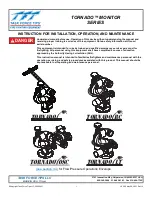
9
When selecting a standard mattress, ensure the distance between top of side rails
(if used) and top of mattress (without compression) is at least 8.66 in (220mm) to
help prevent inadvertent bed exit or falls. Consider individual patient size, position
(relative to the top of the side rail) and patient condition in assessing fall risk.
Skin Care
– Monitor skin conditions regularly and consider adjunct or alternative therapies
for high acuity patients. Give extra attention to skin over any raised side bolster and to any
other possible pressure points and locations where moisture or incontinence may occur or
collect. Early intervention may be essential to preventing skin breakdown.
Patient Entrance / Exit
– Caregiver should always aid patient in exiting the bed. Make
sure a capable patient knows how to get out of bed safely (and, if necessary, how to
release the side rails) in case of fire or other emergency.
Fluids
– Avoid spilling fluids on therapy unit controls. If spills do occur, clean fluid from
pump wearing rubber gloves or while unit is unplugged to avoid any possibility of shock.
Once fluid is removed, check operation of components in area of spill.
Fluids remaining on controls can cause corrosion, which may cause components
to fail or operate erratically, possibly producing potential hazards for patient and
staff.
Moving Parts
- Keep all equipment, tubes and lines, loose clothing, hair and parts of the
body away from moving parts and pinch points.
General Protocols
– Follow all applicable safety rules and institution protocols concerning
patient and caregiver safety.
Power Cord
– Position power cord to avoid a tripping hazard and / or damage to the cord.
Ensure power cord is kept free from all pinch points and moving parts and is not trapped
under casters. Improper handling of the power cord can cause damage to the cord, which
may possibly produce risk of fire or electric shock.
Avoid Fire Hazards
– To minimize risk of fire, connect the bed’s power cord directly into a
wall-mounted outlet. Do not use extension cords or multiple outlet strips. Review and follow
FDA’s Safety Tips for Preventing Hospital Bed Fires.
Tobacco Smoke and other contaminants
- Please follow laundering and cleaning
procedures described in the Care and Cleaning section of this User's Guide. It is
recommended that no smoking occur in, on or around bed environment, so as to avoid
build-up. Severe air restrictions (whatever the cause), may cause the Air Supply Unit to
overheat and automatically deactivate.
Oxygen Use
– DANGER: Risk of explosion if used in the presence of flammable
anesthetics. Use of this product’s pump in an oxygen-enriched environment may produce
potential of fire hazard. This equipment is not suitable for use in the presence of a
flammable anesthetic mixture with air or with oxygen or nitrous oxide. Unplug and do not
use pump when using oxygen-administering equipment other than the nasal, mask or half-
bed-length tent type.
BariMaxx Bariatric Bed System and BariMaxx II Therapy System
- For safest use, Arjo
recommends the BariMaxx Bariatric Bed System or BariMaxx II Therapy System is always
used in conjunction with the MaxxAir ETS MRS, as well as any other safeguards that might
be appropriate.










































